When it comes to securing our homes, installing a reliable lock is paramount. Imagine this scenario: you've just moved into a new house and want to ensure the safety of your family and belongings. Where do you start?
Well, fear not, because we are here to provide you with the best tips for lock installation. From choosing the right lock type to troubleshooting any potential issues, we've got you covered.
So, let's dive into the world of locks and discover how to fortify your home with the utmost confidence.
Choosing the Right Lock Type
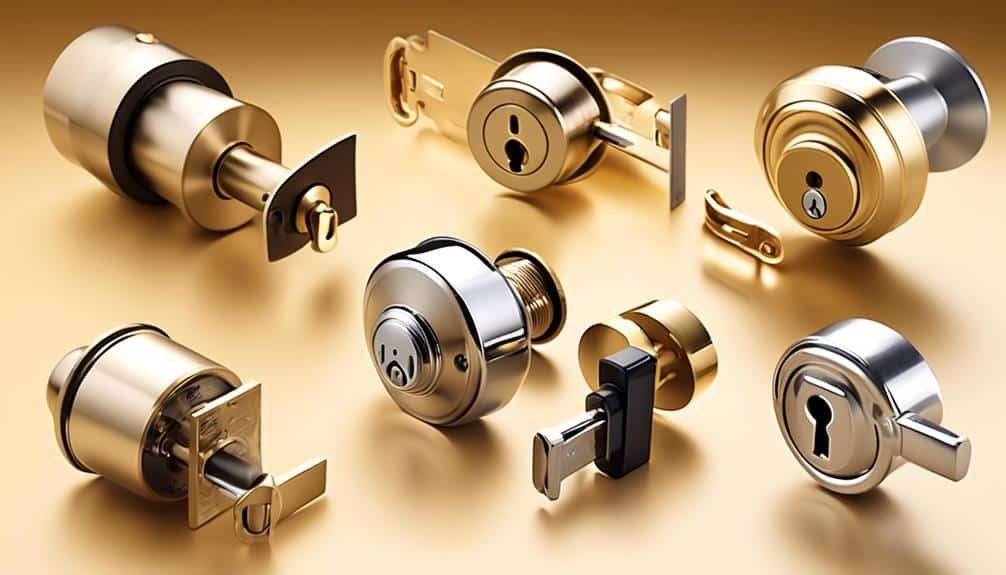
When it comes to selecting the perfect lock for your needs, it's crucial to consider various factors such as security level, functionality, and compatibility with your door or entryway. Choosing the right lock type is an important decision that can greatly impact the overall security of your property. There are several lock types to choose from, each with its own unique features and benefits.
One common lock type is the deadbolt lock. Deadbolts provide excellent security due to their solid construction and resistance to forced entry. They're typically installed on exterior doors and come in single-cylinder and double-cylinder variants. Single-cylinder deadbolts can be locked and unlocked from the inside with a thumbturn, while double-cylinder deadbolts require a key on both sides.
Another popular lock type is the knob lock. Knob locks are commonly found on interior doors and provide a basic level of security. However, they aren't recommended for use as the sole lock on exterior doors, as they can be easily bypassed by intruders.
For higher security needs, consider installing a lever handle lock. Lever handles are easier to operate than knob locks, making them a great choice for people with limited hand mobility. They're often used in commercial settings but can also be installed in residential properties.
Assessing the Security Needs
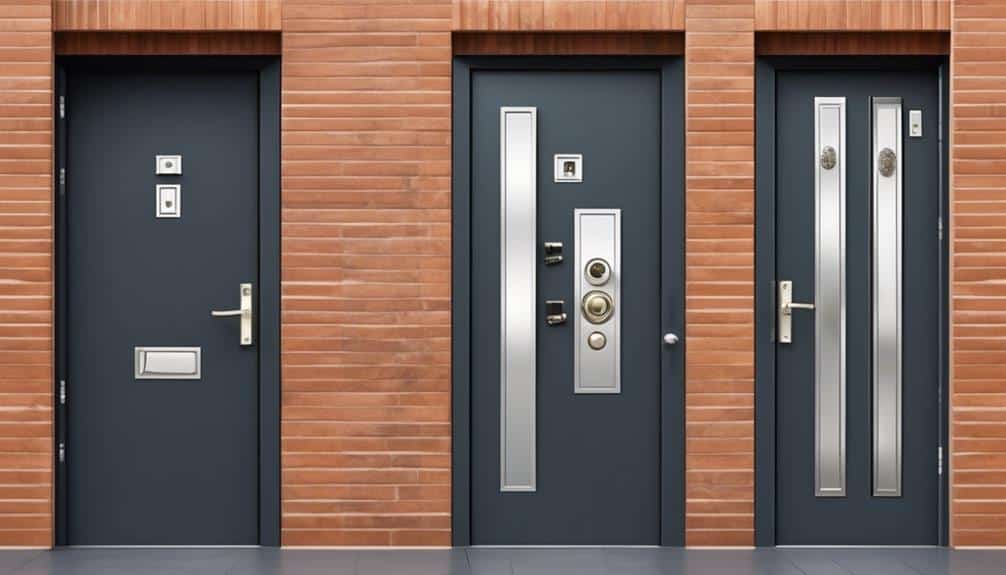
When it comes to assessing security needs, we follow a thorough process to ensure comprehensive protection.
We begin by conducting a detailed security assessment to identify any potential vulnerabilities. This involves evaluating entry points, existing locks, and any areas that may be susceptible to break-ins.
Based on our findings, we then choose the most appropriate lock type that will provide the necessary level of security.
Security Assessment Process
During our thorough security assessment process, we meticulously evaluate the specific security needs of the premises. This involves conducting a comprehensive security audit to identify any vulnerabilities and determine the most effective lock installation solutions.
Our experienced team examines the existing lock systems, assessing their overall condition and performance. We pay attention to any signs of wear and tear, as well as any maintenance issues that may compromise the security of the premises. By conducting regular lock maintenance, we ensure that the locks are functioning optimally and provide the necessary level of security.
Through this detailed evaluation process, we're able to recommend the most suitable lock installation options that meet the specific security needs of the premises, providing our clients with peace of mind and enhanced security.
Identifying Potential Vulnerabilities
To assess the security needs and identify potential vulnerabilities, our experienced team conducts a comprehensive evaluation of the premises. We meticulously analyze the layout, entrances, and existing security systems to determine any potential weaknesses.
This evaluation allows us to identify areas that may require reinforcing security measures. We pay close attention to the quality and functionality of existing locks, ensuring they meet industry standards and are resistant to common break-in techniques. Additionally, we assess the strength of doors, windows, and other access points, looking for any signs of vulnerability.
Our team considers various factors such as location, crime rates, and specific security concerns to develop a customized plan for each client. By identifying potential vulnerabilities, we can recommend and implement the most appropriate lock installation and security measures for optimal protection.
Choosing Appropriate Lock
Our team assesses the security needs by carefully evaluating the layout, entrances, and existing security systems of the premises, ensuring a comprehensive understanding of potential vulnerabilities.
When it comes to choosing the appropriate lock, we consider various factors, including the reputation of lock brands and the suitability of keyless entry systems.
Lock brands play a crucial role in determining the quality and reliability of a lock. We recommend opting for reputable brands known for their durability and resistance to tampering. Brands like Schlage, Kwikset, and Yale have established themselves as industry leaders, offering a wide range of locks suitable for different security needs.
Keyless entry systems have gained popularity due to their convenience and enhanced security features. These systems use electronic keypads, biometrics, or smartphone apps for access control. They eliminate the need for physical keys, which can be lost or duplicated. Keyless entry systems provide an added layer of security with features like temporary access codes and remote access control.
Preparing the Door for Installation
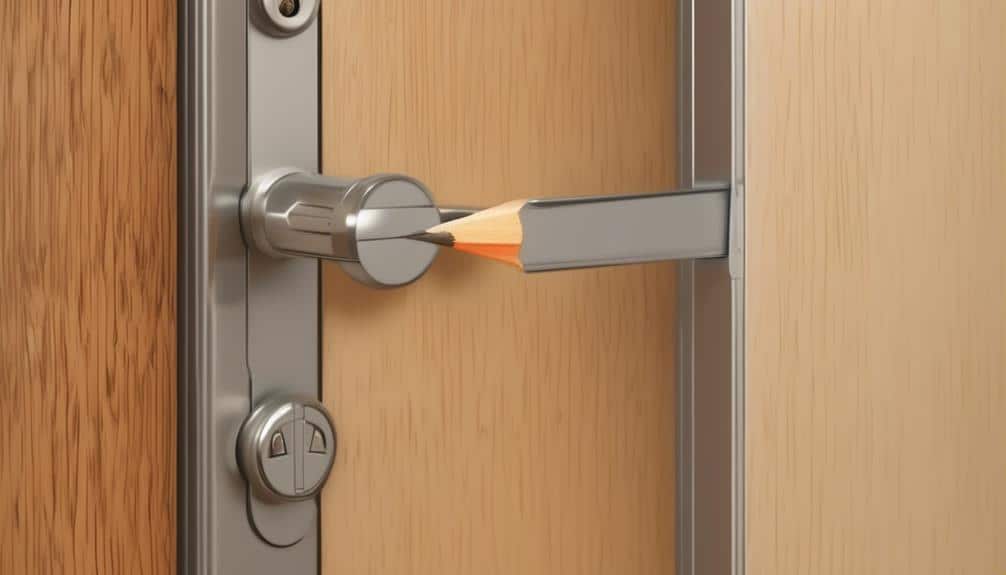
We highly recommend conducting a thorough inspection of the door before proceeding with lock installation. Proper door preparation is essential to ensure the lock functions effectively and provides the desired level of security.
Start by examining the door frame and hinges. Look for any signs of damage, such as cracks or warping, as these can affect the alignment and operation of the lock. Reinforce the door frame if necessary to improve its strength and resistance against forced entry. This can be done by installing a metal strike plate or using a door reinforcement kit.
Next, check the door's material and thickness. Different locks are designed for specific door types, so it's crucial to choose one that's suitable for your door. Measure the door's thickness accurately to ensure compatibility with the lock's backset measurement. If the door is too thin, consider using a door reinforcer or adding a security plate to enhance its strength.
Inspect the door's existing hardware, such as the latch, deadbolt, and strike plate. Ensure they're in good condition and functioning correctly. Replace any worn-out or damaged components to guarantee optimal performance and security.
Lastly, check for any obstructions or obstacles that may hinder the lock's operation. Remove any excess paint, debris, or protruding objects that may prevent the lock from engaging smoothly.
Properly Aligning the Lock
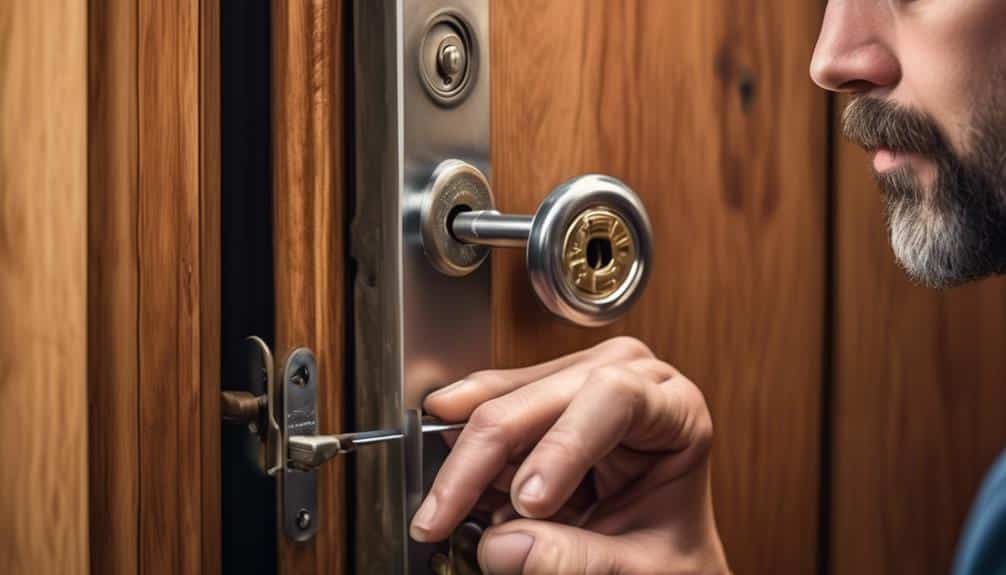
After ensuring that the door is properly prepared, the next step in the lock installation process involves properly aligning the lock to ensure its optimal functionality and security. Proper alignment is crucial for the lock to operate smoothly and securely. To achieve this, it's important to use the right lock installation tools and avoid common lock installation mistakes.
One of the essential tools for aligning a lock is a screwdriver. It's used to adjust the position of the strike plate and the latch. By loosening the screws on the strike plate, the plate can be moved up, down, left, or right to align it with the latch. Once aligned, the screws can be tightened to secure the strike plate in place. Similarly, the latch can be adjusted by loosening the screws that hold it in place and moving it to the desired position.
Common lock installation mistakes include misalignment of the strike plate and latch, which can result in difficulty locking and unlocking the door, as well as decreased security. It's important to double-check the alignment of the lock before finalizing the installation to ensure optimal functionality and security. By using the correct tools and avoiding common mistakes, the lock can be properly aligned, providing peace of mind and protection for your home or business.
Installing the Strike Plate
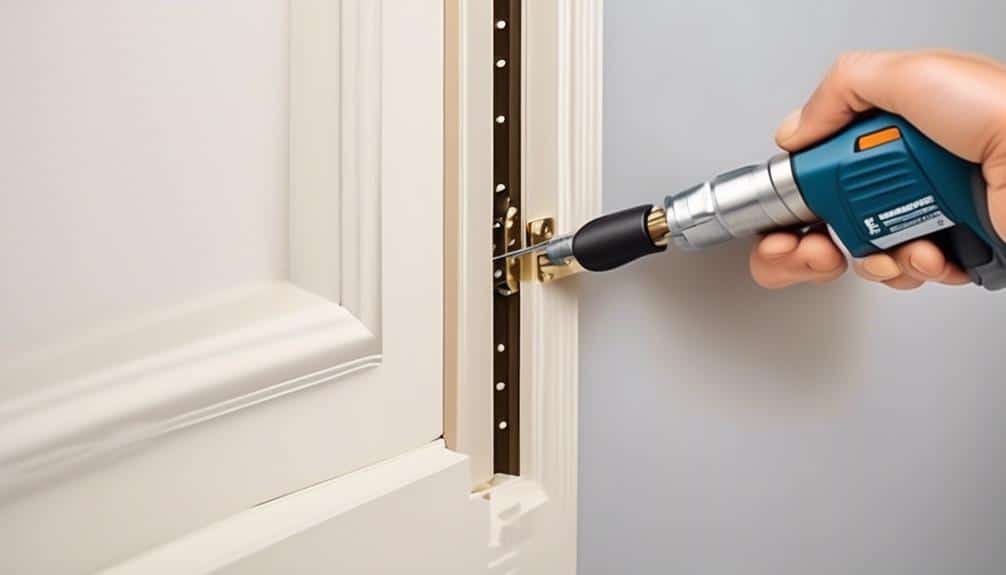
When it comes to installing the strike plate, there are a few key points to keep in mind.
Firstly, proper alignment techniques are crucial to ensure that the strike plate aligns perfectly with the latch. This not only ensures smooth operation but also enhances the overall security of the lock.
Secondly, it's important to ensure a secure attachment of the strike plate to the door frame. This can be achieved by using longer screws that penetrate deep into the frame, providing a strong anchor point.
Lastly, testing the functionality of the strike plate is essential to ensure that the latch engages smoothly and securely.
Proper Alignment Techniques
To ensure proper alignment of the strike plate during lock installation, it is crucial to meticulously follow these detailed and experienced techniques. Proper alignment ensures that the door locks securely and functions smoothly. Before installing the strike plate, it is important to prepare the door by creating a mortise, or recess, for the plate. This involves carefully chiseling out the area where the strike plate will be positioned. Once the door is prepared, the strike plate can be installed using the following alignment techniques:
| Technique | Description |
|---|---|
| Tape alignment method | Place a strip of tape on the door jamb and close the door. Mark the center of the latch bolt on the tape. |
| Lip alignment method | Align the lip of the strike plate with the edge of the door. |
| Shim technique | Use shims to adjust the strike plate vertically and horizontally for precise alignment. |
| Strike plate template | Utilize a strike plate template to ensure accurate positioning of the plate. |
Ensuring Secure Attachment
Now that the door has been prepared with a mortise for the strike plate, it's imperative to securely attach the strike plate to ensure optimal functionality and security of the lock.
Ensuring proper installation of the strike plate is crucial for the overall effectiveness of the lock mechanism. To begin, align the strike plate with the mortise on the door frame, making sure it sits flush against the surface.
Next, mark the position of the screw holes on the frame using a pencil or marker. Pre-drill pilot holes into these marked spots to prevent any splitting of the wood when inserting the screws.
Once the pilot holes are created, attach the strike plate to the door frame using the provided screws. Tighten the screws firmly, but be careful not to overtighten and strip the holes.
Testing for Functionality
We highly recommend conducting a thorough functionality test after securely attaching the strike plate to ensure that the lock operates smoothly and provides the desired level of security.
Here are four key steps to follow during the functionality testing process:
- Test the latch: Insert the latch into the strike plate and attempt to retract it using the door handle. Ensure that it moves freely without any resistance or sticking.
- Check the deadbolt: Engage the deadbolt and attempt to lock and unlock it using the key or thumb turn. Verify that it extends fully into the strike plate and retracts smoothly.
- Test the strike plate alignment: Close the door and observe whether the latch and deadbolt properly align with the strike plate. Any misalignment could compromise the lock's security.
- Check for proper bolt projection: When the lock is engaged, verify that the latch and deadbolt extend far enough into the strike plate to prevent the door from being easily forced open.
Testing and Adjusting the Lock

After completing the lock installation, it's crucial to thoroughly test and make any necessary adjustments to ensure proper functionality. One important aspect to consider is door alignment. A misaligned door can cause problems with the lock, such as difficulty in turning the key or the latch not properly engaging. To check the alignment, close the door and observe if there are any gaps between the door and the frame. If there are gaps, adjustments may be needed to ensure a proper fit.
Next, it's essential to perform lock maintenance to guarantee smooth operation. This involves testing the lock's functionality by inserting and turning the key, as well as testing the latch. The key should turn smoothly without any resistance, and the latch should retract and extend easily. If there are any issues, adjustments may be necessary. This could involve lubricating the lock mechanism or adjusting the strike plate for proper alignment.
Additionally, it's important to test the lock's security features. This includes checking if the deadbolt extends fully into the strike plate and if the latch is secure when fully engaged. Any deficiencies in these areas should be addressed promptly to ensure the lock's effectiveness.
Maintaining and Troubleshooting Locks
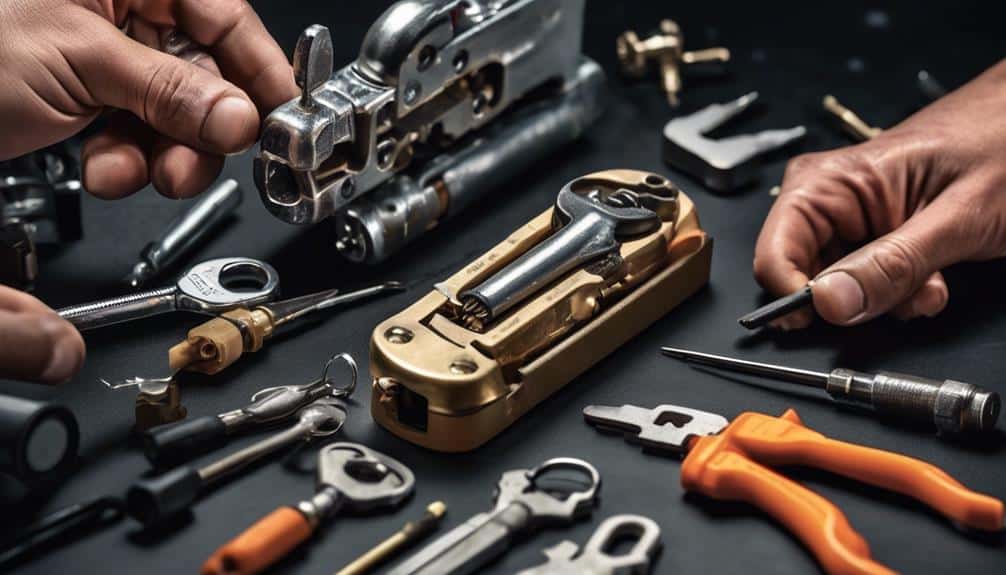
To properly maintain and troubleshoot locks, it's crucial to regularly assess their functionality and address any issues that may arise during the lock installation process. By following these lock maintenance techniques and troubleshooting common issues, you can ensure that your locks are in optimal condition and provide the necessary security for your premises.
- Lubrication: Regularly lubricating your locks is essential for smooth operation. Apply a high-quality graphite lubricant or silicone-based spray to the keyway and moving parts of the lock. This helps prevent friction and ensures the lock functions properly.
- Cleaning: Dust and debris can accumulate in locks over time, affecting their performance. Use a compressed air canister or a small brush to remove any dirt or particles from the lock mechanism.
- Key Inspection: Inspect your keys regularly for signs of wear or damage. Worn keys can cause the lock to malfunction or become difficult to operate. If you notice any issues, consider getting a new key made.
- Tightening Loose Screws: Over time, screws in lock mechanisms may become loose. Periodically check and tighten any loose screws to maintain the lock's integrity.
Frequently Asked Questions
What Are the Different Types of Locks Available in the Market?
When it comes to locks, there's a wide variety of options available in the market. Different types of locks cater to specific needs and security requirements.
From traditional deadbolt locks to smart electronic locks, each has its own advantages and disadvantages. Understanding these different types of locks can help you make an informed decision when it comes to lock installation.
Lock picking techniques and the pros and cons of electronic locks are important factors to consider in this process.
How Do I Determine the Level of Security Needed for My Home or Business?
When it comes to keeping our homes and businesses safe, choosing the right security level is crucial.
Determining the appropriate level of protection for our property requires careful consideration and expertise.
We understand the importance of safeguarding what matters most to you, and that's why we're here to help.
Our team of experienced professionals can guide you through the process, ensuring that you have the peace of mind knowing that your home or business is secure.
Trust us to provide the best security solutions for you.
What Tools and Materials Are Required to Prepare a Door for Lock Installation?
When it comes to lock installation, having the right tools and materials is crucial for a successful job. The installation tools needed include a drill, screwdriver, chisel, and a hole saw.
As for door preparation materials, you'll need a tape measure, pencil, masking tape, and a template for accurate placement.
These tools and materials ensure that the door is properly prepared for the lock installation, resulting in a secure and functional lock system.
How Can I Ensure That the Lock Is Properly Aligned During Installation?
To ensure proper alignment during lock installation, we've found a few key techniques that work well.
First, make sure to mark the exact location where the lock will be installed. This will help you align it correctly.
Additionally, using a level can ensure that the lock is straight and not tilted.
Finally, double-check the alignment by testing the lock before fully securing it in place.
These steps will help ensure a properly aligned and secure lock installation.
How Often Should Locks Be Maintained and What Are Some Common Troubleshooting Tips?
Lock maintenance frequency and troubleshooting common issues are important aspects of keeping your locks in good working order. Regular maintenance is crucial to ensure the longevity and functionality of your locks. By following a regular maintenance schedule, you can prevent potential problems such as jamming or key sticking.
Additionally, troubleshooting common issues like loose screws or misalignment can help to address any problems before they become more serious. Taking these steps will help to ensure the overall security and effectiveness of your locks.


